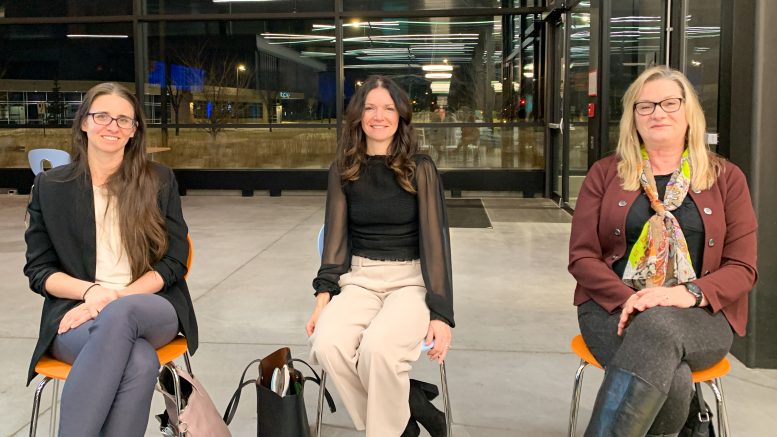On Feb. 22, the University of Manitoba’s Café Scientifique hosted a session on innovative health-care technologies and their use in understanding and improving patient experiences.
The panelists included a team of interdisciplinary researchers who spoke on developments in health-care technology since the onset of the COVID-19 pandemic, and on how those developments have provided more accessible and patient-centred care.
U of M assistant professor in the department of psychiatry and Health Sciences Centre and Crisis Response Centre staff psychiatrist Jennifer Henzel discussed the expansive growth of telemedicine and virtual care in Manitoba.
The provision of virtual medical care has been applied in the health-care industry for decades. However, Henzel noted that virtual care was done in very limited ways before the COVID-19 pandemic, especially in psychiatry.
“That was an area that there wasn’t a lot of comfort and experience dealing with people who are in their home as opposed to in a health-care setting,” she said.
Henzel said that the pandemic pushed those in psychiatry to make advancements in virtual care, and that those advancements have been promising.
“There were a lot of skeptics before the pandemic, and I think now everybody is realizing that this is something that has significant potential in health care,” she added.
Recently, Henzel helped launch an emergency rural telepsychiatry service, which offers virtual assessments for those experiencing a mental health crisis in rural Manitoba. Since being introduced in 2021, the service has received about 500 calls.
“We’re avoiding unnecessary transfers, hospitalizations and bringing care to people in their home communities,” Henzel said.
Additionally, she assisted in the implementation of a virtual hospital for mental health crisis stabilization, offering intensive online support to those at home in need of assistance.
Henzel highlighted the emergence of cognitive behavioral therapy and mental health and wellness apps to assist with things like self-monitoring and the development of coping skills.
Institutions like CancerCare Manitoba have adopted apps such as Noona, which allows patients to provide real time input directly to their clinical team regarding the symptoms they are experiencing.
Although the use of these technologies is now widespread, U of M assistant professor and Rady chair in interprofessional collaborative practice Gayle Halas pointed out that there was initially a low use of technology in patient-provider communication prior to March 2020 in Canada.
“During the height of the COVID pandemic and when we were faced with physical distancing measures for public protection, not only was this a new means for visiting health-care providers during COVID, but it was the dominant option for addressing health-care concerns,” Halas said.
Halas brought together a multi-disciplinary team to investigate the rapid introduction of virtual visits in health care.
The team obtained nearly 700 surveys for analysis and ran nine focus groups speaking with patients and caregivers that discussed the ease or difficulty of virtual care, the quality of virtual visits and how virtual health care might proceed in the future.
Overall, Halas’s team found that virtual care was a suitable complement to in-person consultations.
“Participants believed that virtual care did have a place in the health system and that [it was] better suited to address some issues over others, but that patients should be given a choice based on their preferences, and this could perhaps even be together in consultation with their provider,” she said.
Halas said that her team wanted to highlight the importance of patients’ reported experiences with their research.
“It is essential that we get this kind of feedback and that it is obtained from those most impacted by system changes, like the rapid introduction of virtual care,” she said.
Health quality and patient-reported measurement lead at the George & Fay Yee Centre for Healthcare Innovation Sarah Kirby also emphasized the importance of patient feedback and its contribution to more patient-centred care.
This includes using what are known as patient-reported measures — extensively tested surveys that can be used as standardized tools to understand patients’ experiences during service, as well as their care outcomes.
Kirby noted how the focus that the retail industry has regarding the use of feedback-based data to improve products and services could be applied within the world of medicine.
“In a publicly funded health-care system where we report to be patient-centred, and where we’re facing a lot of struggles going forward with resource allocation, especially post-pandemic, it seems to me that it makes sense that we would include patients and the public’s perspective when we’re measuring our health-care resource distribution, and to learn more about whether the health-care services that we’re providing are meeting the needs of patients,” Kirby said.
Kirby explained that by using patient-reported outcome data alongside other clinical data, a more complete story of how our health-care system functions can be shown, and can be used to inform bigger policy decisions.
Kirby emphasized that the continued adoption of technologies in the health-care system should be informed by the patients using them. She also noted the patient data that these technologies could provide.
“These technologies themselves are excellent tools that we can use to actually routinely collect information from patients about whether our care is meeting their needs, about whether they are having a good experience,” she said.



